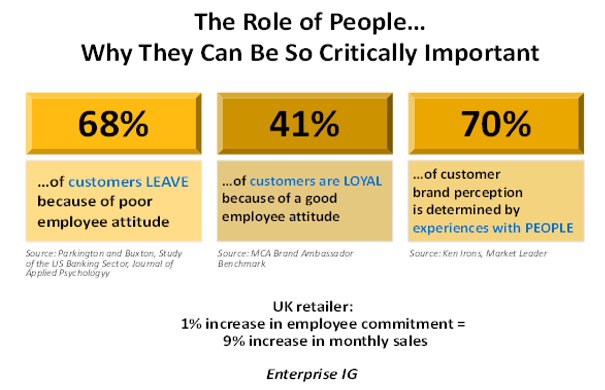There was a recent line of discussion – “What is the optimal number of KPIs?” – in the CMO Network professional group on LinkedIn. The principal observation was that marketers put so many KPIs in place (and often confuse KPIs with metrics) that they become meaningless. So, there was a request for feedback from CMO Network members on what they felt was an optimum number.
As you’d expect, because these are marketers, a variety of responses came back:
- Balanced approach, with some KPIs at a high level and some that are more granular
- Have just a few KPIs
- Have 1 or 2 KPIs
- Have 3 or 4 KPIs
- However many KPIs, make sure they are focused and aligned
So, this certainly could not be identified as unanimity of perspective within the ranks.
Going past the suggestion that KPIs and performance metrics are (or should be) somehow different, with disparate goals and objectives in application, the measure(s) question still remains an important one for any enterprise. From a customer-centricity and customer experience management perspective, which is the loyalty “sweet spot” of organization and execution for any enterprise, I’d begin with a blog that Bob Thompson wrote almost a decade ago, “Find the ‘Ultimate’ Loyalty Metric to Grow Your Business”.
At base, the blog was a discussion of the use, and many challenges, of NPS to identify drivers of business growth and a call a) to keep surveys succinct, b) to recognize that there are other business objectives of merit (such as improving gross margins, net operating cash flow, and shareholder return), and c) to remind researchers, through the introduction of NPS, that they needed needed to be more practical.
In the blog, written on October 1st, 2007, Bob predicted that NPS would peak in the coming year, and then decline. It hasn’t; and, in fact, if anything it has become more institutionalized, now being (questionably) extended as a method to measure employee behavior. Two of the key recommendations Bob included in the blog were:
#5 – “Reward managers and employees for improving customer loyalty…..and (per Jeanne Bliss)….drive change within the organization to ‘get people to work better together’ serving customers.”
#6 – “Plan to evolve and refine your measurements and rewards. You’ll need to make adjustments over several years to keep it working just right.”
Frankly, the evidence of experience in monitoring and working with many organizations has shown that relatively little of Bob’s great advice has been taken and applied. This is especially true where individual and team-based employee contribution to customer experience and customer behavior is concerned. With most companies still focused on measuring employee satisfaction, or happiness on the job, and engagement, which is principally about fit , productivity and alignment, their impact on customer loyalty and advocacy rarely comes into the KPI discussion.
Bob’s blog concluded with a reprise of the key message: “Is there one ‘ultimate question’ that will effectively measure customer loyalty for all businesses? The short answer: No. But the ‘ultimate answer’ is that you must figure out the right metrics for your business. What’s at stake is your customers’ loyalty – and your future success.”
Employee Commitment Impacts Customer Behavior
As I’ve been stating for over a decade, I’d submit that, once an organization has framed (or reframed) the optimal emotional and rational components of customer experience, they would be well-advised to apply the same broadened new-age thinking, and similar approaches, to the employee experience as well. For years, academic and professional studies have chronicled both the direct and indirect effect of employee commitment on customer behavior:

With that in mind, consideration of employee impact should be actively reflected in how overall enterprise performance is measured.
There is a metric/KPI, or more appropriately a multi-question framework (not an index) that will help sustain and continue to improve it. That framework is customer advocacy behavior: Advocacy is built on positive perception, active purchasing and a strong and supportive, vocal bond with a supplier, selected from all those that might be considered. A good portion of how customers behave toward, and bond with, a supplier has to do with employee commitment – to the company, to the product/service value proposition, and to the customers themselves. Employee commitment, which we define as ambassadorship, is a way of understanding customer effect that transcends both satisfaction and engagement. It directly influences customer advocacy.
One of the most useful, and granular, applications of customer advocacy measurement is that it can connect elements of employee behavior and brand value to the customer experience. If, for example, a bank wanted to determine how much employees and brand equity were impacting customer loyalty, especially relative to the bank’s value proposition itself, this could readily be determined, per the following example:

Note that, not atypically, employee contribution to positive customer emotional response to experiences and transactions is, along with brand perception, stronger than key components of the value proposition itself. In our consulting and research assignments, we consistently see results such as these.
Here’s the bottom line: There’s nothing more powerful than linking causation with proof. That proof includes both employee-related and brand-related components. Extensive research in businesses around the world has demonstrated that a KPI, or metric, can be expressed as a single measure (as NPS originally postulated) — with the important proviso that it was drawn from an aggregated, relevant, and actionable (on a granular level) set of customer experience and behavior elements and drivers, not just a single, and questionable, question.



